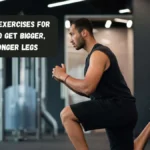Not only does having toned and strong glutes make you look better, but it also helps with posture, lower back pain, and general athletic success. The biggest group of muscles in the body are the gluteal muscles, which are made up of the gluteus maximus, medius, and minimus.
To work these muscles and make them stronger, you need to do both complex and isolation workouts. There are many great workouts for working your glutes, and these will help you no matter how experienced you are.
Squats
People often say that squats are the best workout for your lower body, and they’re right. The gluteus maximus, quads, hamstrings, and core are the main muscles they work. You should stand with your feet shoulder-width apart, keep your back straight, and squat down until your legs are straight out from your body. You work your glutes well when you push back up through your feet.
Adding weights, like a barbell or bars, can make working the hips a lot more difficult. When you do variations like front squats or stop squats, you work the gluteal muscles even more. Keep your knees straight and your toes touching. Also, don’t lean too far forward, because that could make the glute contact less effective.
Sumo Squats
Sumo squats are a strong variation on regular squats that are meant to work the inner legs and hips more effectively. When you stand, your feet should be wider than shoulder-width apart, and your toes should point out at a 45-degree angle. Keep your chest up and your core tight as you lower yourself into a squat.
At the top of the action, squeeze your glutes as you come back up. This wide stance puts more stress on the gluteus maximus and medius, which makes it a great way to work on the outside of your glutes. Adding a kettlebell or bar between your legs can make the workouts more difficult and help you get stronger and bigger faster.
Lunges
Lunges are a powerful workout that work the glutes and make you more balanced and coordinated. Along with the quads and hamstrings, they work all three gluteal muscles. Step forward with one leg and drop your hips until both knees are 90 degrees to each other. Make sure that your front knee doesn’t go past your toes and stays right above your ankle. To get back to where you started, push through your front leg.
Walking lunges, reverse lunges, and Bulgarian split squats are some variations that change things up and work different parts of the hips. Holding dumbbells while lunging makes the exercise more difficult and helps muscles grow. Lunges also work the supporting muscles in the hips, which are important for keeping your body strong and avoiding injuries.
Hip thrusts
One of the best ways to work out your glutes, especially the gluteus maximus, on its own is to do hip thrusts. For this move, you should sit on the ground with your back against a bench and roll a heavy barbell over your hips. Keeping your feet firmly on the floor, you lift your hips up and squeeze your glutes as you reach the top. Then you lower yourself back down.
To fully activate your glutes, make sure you don’t arch your lower back and focus on pushing through your feet. When you do hip thrusts, you put a lot of stress on your glutes, which makes them bigger and stronger. They are especially helpful for people who want to get better at quick moves like jumping and running. As a person gets stronger, they can move on to resistance bands or weights, or they can start with bodyweight thrusts.
Glute Bridges
Glute bridges are a great way to focus and strengthen the glutes. They are easy for beginners to do and work very well. Lay on your back with your knees bent and your feet flat on the floor, hip-width apart. This is the glute bridge. Press through your feet and squeeze your glutes as you lift your hips up.
Slowly lower your hips back down. This workout is great for working out the glutes without putting too much strain on the lower back. It’s also a great way to warm up before doing more difficult moves like squats or deadlifts. Adding more resistance is easy: put a weight plate or dumbbell on your hips, or wrap a resistance band around your legs. Regularly doing glute bridges can help fix muscle issues and make it easier to move your hips.
Step-Ups
A useful exercise that works the hips, hamstrings, and quads at the same time is the step-up. This movement looks a lot like normal things we do, like climbing stairs, so it’s easy to use in real life. Stand in front of a bench or other stable surface to do step-ups. Lift your body up by pressing through your heel as you step up with one leg. Then, step back down. For each rep, switch legs, or do all of your reps on one side before moving.
Keeping the bars at your sides makes the workout harder and helps you build power on one side. Step-ups are a great way to fix imbalances between your left and right hips, which can help you avoid injuries and improve your balance generally. There is also an aerobic aspect to them, especially when done faster or with more reps.




